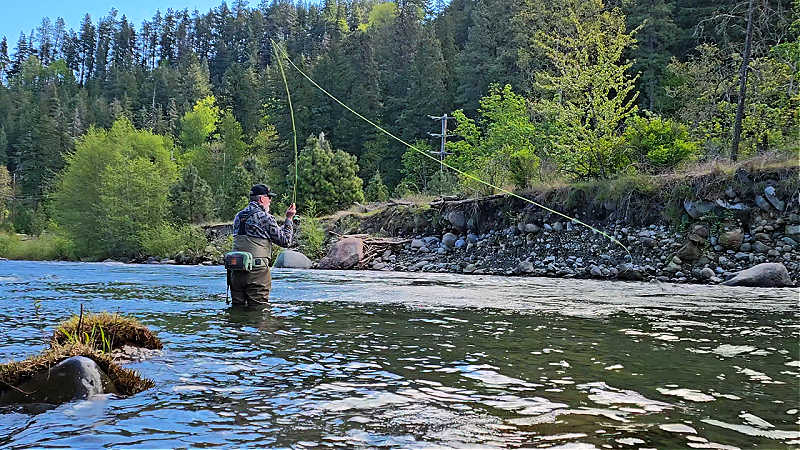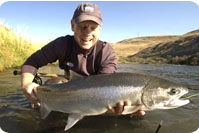
Spey Casting Articles... -
Spey casting is a traditional Scottish style of fly casting which utilizes long two-handed rods. Dating back to the 18th century, the original rods from the River Spey measured 16 to 20 feet long. However, modern Spey rods now range from 16 to 11 feet with an average around 13 feet or so. While two-handed rods can be used for over-head casting, most anglers are using them with both traditional and modern Spey casting techniques. Similar to a roll cast, Spey casting utilizes water tension to load the rod. With that said, roll casting doesn’t allow the angler to change casting direction efficiently. However, Spey casts allow the angler to change casting direction with total efficiency. There are numerous different Spey casts which allow the angler to easily present their fly despite the fishing conditions. There are many reasons Spey casting has become the dominate style of casting on steelhead rivers of all sizes. To begin with, two-handed casting allows the angler to cast with very little back-casting room, a huge attribute on many tree lined steelhead rivers. More so, the distance one can obtain with a Spey rod is incredible. In the game of steelheading, covering lots of water is critical for success. Furthermore, the quick set-up and casting cycle allows Spey anglers to get way more casts in during the day when compared to single hand casting. When you’re fishing for a fish that takes 1000 casts, this is key. Plus, Spey casting uses the wind to help load the rod during the cast. On big, open rivers, it pays to work with the wind. Additionally, modern Spey lines allow anglers to fish any style of fly line with far less fatigue to the body. More importantly though, the length of two-handed rods allows the angler to control the presentation of the fly. Steelhead fishing is a game of line control... Total command of the water. The steelhead anglers that succeed on a regular basis are all about the swing speed of their fly. Finally, Spey casting is a blast! Steelhead junkies spend a lot of time between fish. Having the distraction of learning a challenging skill only adds to the enjoyment of the sport.
Line Weight
If you had to choose just one “do everything” two-handed rod, it would more than likely be a seven weight. With that said, there are a few things to consider when purchasing your next Spey rod. To begin with, how big are the fish you intent to chase? A seven weight will easily handle steelhead in the 8 to 14 pound range. Matched with the proper line, a seven can handle anything from floating lines to sink-tips. However, if you plan on fishing rivers with large steelhead, you’ll be under-gunned with a seven weight. On many Canadian summer rivers and most winter rivers in the Northwest, hooking a 15 to 20 pound fish is an everyday reality. You’d be better off using an eight or nine weight rod. Furthermore, if your faced with fishing conditions that require throwing heavy sink-tips and big flies, an eight or nine makes it easier. On the other hand, if you plan on fishing one salt summer steelhead where the average fish is 5 to 7 pounds, a six weight would be more applicable. These rods are great for fishing floating lines and surface presentations. Most folks will start with a seven weight, then build their arsenal of weapons to fit their specific fishing needs. Length
The length of a rod equates to casting distance. Simply put, the longer the rod, the longer the cast. The shorter the rod, the more finesse it tight casting conditions. A good all around length is 13' to 13'6. This will allow the caster to reach a lot of water without fatigue over a long day of fishing. However, there are times where a longer or shorter rod comes in handy. For example, if you primarily fish large rivers that require monster casts, a fourteen to sixteen rod is the tool of choice. The Clearwater and Thompson rivers come to mind. Conversely, small coastal streams are often very limited on back casting room. More so, these rivers don’t usually demand the length of casts big rivers do. A 11' to 12'6 rod makes life a whole lot easier when you’re limited on space. When selecting your next rod, base your decision on the rivers you indent to use it on the most. Rod Action
Action can be best described by how deep the rod flexes during a cast. A slow action rod bends well into the butt section during the casting stroke. This allows the caster to really feel the rod load. A slower action stick is great for casting with limited back casting space because the rod loads with minimal D-loop or back cast speed. The disadvantage is you can not generate as fast of line speed as a quicker action rod. Furthermore, it is more difficult to lift heavy sink-tips and large flies out of the water. With that said, Skagit casting guru Ed Ward loves full flexing rods like the Dredger series from G.Loomis for casting heavy tips and big flies. You just need to take your time with slower action two-handers. A medium to medium-fast action rod will suite most average casters the best. The caster can still feel the rod load with a medium action, while faster line speeds can be obtained. The Sage Z-Axis series, the Winston BIIx series, and the Burkhiemer Classics are all good examples of medium action Spey rods. Medium action rods will handle a wide range of casting strokes and line types. Fast action rods are for the angler that demands high line speed from their weapon. Good examples of fast action Spey rods would be the Echo2 series and the Sage TCR series. These rods really shine with shooting taper style lines. While most folks will struggle with a fast rod, expert casters can command the water with one. That isn’t to say that all experts use fast rods. More times than not, most advanced casters still lean towards a medium to medium fast sticks. Obviously, action preference is a personal choice. There is no right or wrong, only what fits your casting stroke and fishing demands the best. 
| 




